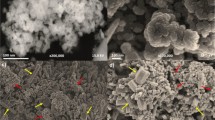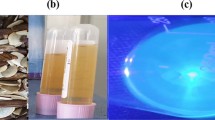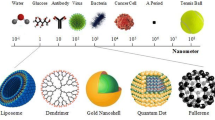Abstract
This study focuses on the synthesis and characterization of new magnetic nanoparticles complexed with copper, designated as Fe3O4@gly@cyclohexylidene-spiro[indoline-[1,3]dithiine]@Cu (FMNP). The structural confirmation of these nanoparticles was achieved through several techniques, including SEM imaging, VSM curves, XRD patterns, TGA and DTG curves, ICP-OES spectroscopy, and FT-IR spectrum analysis. Quantum mechanical studies were also conducted to precisely determine the complex’s position. These nanoparticles demonstrated antimicrobial properties against fungal, Gram-negative, and Gram-positive bacterial strains. The minimum fungicidal concentration (MFC) values ranged from 64 to 128 μg/mL, and the minimum bactericidal concentration (MBC) values varied between 8 and 256 μg/mL, indicating superior inhibitory effects on some microbial species compared to existing antibiotics. Furthermore, the FMNP nanoparticles were utilized in fabricating a crosslinked Oxidized Pectin-Fish Collagen Peptides hydrogel (FHGEL) aimed at adsorbing Congo red from aqueous solutions. The study of FHGEL’s adsorption capacity revealed that incorporating 0.03% FMNP significantly enhanced its ability to adsorb Congo red, showing a 3- to 4-fold increase compared to the hydrogel alone. The adsorption mechanism was attributed to dispersion mechanisms and the relaxation of macromolecules within a three-dimensional polymer network. This was supported by the FHGEL’s adsorption data fitting the R–P model, with the heterogeneity factor (n) value from the Sips isotherm model approaching 1.5, and a maximum adsorption capacity of 750.4 mg/g as predicted by the R–P model. The research findings indicate that all hydrogels adhere to the pseudo-second-order kinetics model, suggesting that FMNP could hold promising applications in the field of nanotechnology and environmental remediation.


















Similar content being viewed by others
Data Availability
Data is provided within the manuscript or supplementary information files.
References
Lima EC (2018) Removal of emerging contaminants from the environment by adsorption. Ecotoxicol Environ Saf 150:1–17
Qi X, Tong X, Pan W, Zeng Q, You S, Shen J (2021) Recent advances in polysaccharide-based adsorbents for wastewater treatment. J Clean Prod 315:128221
Hunger K, Mischke P, Rieper W, Raue R, Kunde K, Engel A (2005) Azo Dyes in Ullmann’s encyclopedia of industrial chemistry. Wiley-VCH, Weinheim 10:07
Nasrollahzadeh M, Issaabadi Z, Sajadi SM (2018) Green synthesis of a Cu/MgO nanocomposite by Cassytha filiformis L. extract and investigation of its catalytic activity in the reduction of methylene blue, Congo red and nitro compounds in aqueous media. RSC Adv 8:3723–3735
Shafqat SR, Bhawani SA, Bakhtiar S, Ibrahim MNM (2020) Synthesis of molecularly imprinted polymer for removal of Congo red. BMC Chem 14:1–15
Paul A, Das K, Karmakar A, da Silva MFCG, Pombeiro AJ (2020) A mechanistic insight into the rapid and selective removal of Congo Red by an amide functionalised Zn(II) coordination polymer. Dalton Trans 49:12970–12984
Lahreche S, Moulefera I, El Kebir A, Sabantina L, Benyoucef A (2022) Application of activated carbon adsorbents prepared from prickly pear fruit seeds and a conductive polymer matrix to remove congo red from aqueous solutions. Fibers 10:7
You J, Liu C, Feng X, Lu B, Xia L, Zhuang X (2022) In situ synthesis of ZnS nanoparticles onto cellulose/chitosan sponge for adsorption–photocatalytic removal of Congo Red. Carbohydr Polym 288:119332
Sahoo JK, Paikra SK, Mishra M, Sahoo H (2019) Amine functionalized magnetic iron oxide nanoparticles: synthesis, antibacterial activity and rapid removal of Congo Red dye. J Mol Liq 282:428–440
Nasrollahzadeh M, Sajadi SM, Sajjadi M, Issaabadi Z (2019) Applications of nanotechnology in daily life. Interface Sci Technol 28:113–143
Emerich DF, Thanos CG (2003) Nanotechnology and medicine. Expert Opin Biol Ther 3:655–663
Moore JA, Chow JC (2021) Recent progress and applications of gold nanotechnology in medical biophysics using artificial intelligence and mathematical modeling. Nano Express 2:022001
Occhiutto ML, Maranhão RC, Costa VP, Konstas AG (2020) Nanotechnology for medical and surgical glaucoma therapy—a review. Adv Ther 37:155–199
Usman M, Farooq M, Wakeel A, Nawaz A, Cheema SA, ur Rehman H, Ashraf I, Sanaullah M (2020) Nanotechnology in agriculture: current status, challenges and future opportunities. Sci Total Environ 721:137778
Achari GA, Kowshik M (2018) Recent developments on nanotechnology in agriculture: plant mineral nutrition, health, and interactions with soil microflora. J Agric Food Chem 66:8647–8661
Acharya A, Pal PK (2020) Agriculture nanotechnology: translating research outcome to field applications by influencing environmental sustainability. NanoImpact 19:100232
Jagtiani E (2022) Advancements in nanotechnology for food science and industry. Food Front 3:56–82
Mohammad ZH, Ahmad F, Ibrahim SA, Zaidi S (2022) Application of nanotechnology in different aspects of the food industry. Discov Food 2:12
Thiruvengadam M, Rajakumar G, Chung I-M (2018) Nanotechnology: current uses and future applications in the food industry. 3 Biotech 8:1–13
Cheng C, Song W, Zhao Q, Zhang H (2020) Halloysite nanotubes in polymer science: purification, characterization, modification and applications. Nanotechnol Rev 9:323–344
Golmohammadi M, Sabbagh Alvani A, Sameie H, Salimi R (2019) Characterization of photocatalytic nanocomposites contains reduced graphene oxide and polymeric membrane for dye degradation purpose. J Stud Color World 9:13–22
Peng B, Tang J, Luo J, Wang P, Ding B, Tam KC (2018) Applications of nanotechnology in oil and gas industry: progress and perspective. Can J Chem Eng 96:91–100
Zhou K, Zhou X, Liu J, Huang Z (2020) Application of magnetic nanoparticles in petroleum industry: a review. J Petrol Sci Eng 188:106943
Sameie H, Salimi R, Alvani AS, Sarabi A, Moztarzadeh F, Tahriri M (2010) Evaluation of sol–gel derived Eu2+ activated SrMgAl2SiO7 as a novel nanostructure luminescent pigment. Physica B 405:4796–4800
Hedayati H, Alvani AS, Sameie H, Salimi R, Moosakhani S, Tabatabaee F, Zarandi AA (2015) Synthesis and characterization of Co1−xZnxCr2−yAlyO4 as a near-infrared reflective color tunable nano-pigment. Dyes Pigm 113:588–595
Salimi R, Sameie H, Alvani AS, Sarabi A, Mohammadloo HE, Nargesian F, Alvani MS, Tahriri M (2013) SrZn2Si2O7: Eu2+, Mn2+: a single-phased emission tunable nanophosphor suitable for white light emitting diodes. JOSA B 30:1747–1754
Samani FN, Darvishi R, Moshkriz A, Darvish M (2023) Oxidized pectin-cross-linked O-carboxymethyl chitosan/EDTriAA intercalated LDH: an antibiotic adsorbent hydrogel. J Polym Environ 31:1–18
Salimi R, Sameie H, Sabbagh Alvani A, Sarabi A, Moztarzadeh F, Eivaz Mohammadloo H, Nargesian F, Tahriri M (2012) Sol–gel synthesis, structural and optical characteristics of Sr1–xZn2Si2yO7+δ:xEu2+ as a potential nanocrystalline phosphor for near-ultraviolet white light-emitting diodes. J Mater Sci 47:2658–2664
Salimi R, Sameie H, Sabbagh Alvani A, Sarabi A, Moztarzadeh F, Tahriri M (2011) Sol–gel synthesis, characterization and luminescence properties of SrMgAl2SiO7: Eu2+ as a novel nanocrystalline phosphor. Luminescence 26:449–455
Moosakhani S, Alvani AAS, Mohammadpour R, Sainio J, Ge Y, Hannula S-P (2018) Effect of sulfonating agent and ligand chemistry on structural and optical properties of CuSbS2 particles prepared by heat-up method. CrystEngComm 20:1527–1535
Dong L, Chen G, Liu G, Huang X, Xu X, Li L, Zhang Y, Wang J, Jin M, Xu D (2022) A review on recent advances in the applications of composite Fe3O4 magnetic nanoparticles in the food industry. Crit Rev Food Sci Nutr 64:1–29
Abdtawfeeq TH, Farhan ZA, Al-Majdi K, Jawad MA, Zabibah RS, Riadi Y, Hadrawi SK, Al-Alwany A, Shams MA (2022) Ultrasound-assisted and one-pot synthesis of new Fe3O4/Mo-MOF magnetic nano polymer as a strong antimicrobial agent and efficient nanocatalyst in the multicomponent synthesis of novel pyrano [2, 3-d] pyrimidines derivatives. J Inorg Organomet Polym Mater 33:1–12
Moghaddam-manesh M, Sargazi G, Roohani M, Zanjani NG, Khaleghi M, Hosseinzadegan S (2022) Synthesis of PVA/Fe3O4@ SiO2@ CPS@ SID@ Ni as novel magnetic fibrous composite polymer nanostructures and evaluation of anti-cancer and antimicrobial activity. Polym Bull 80:1–12
Darvishi R, Moghadas H, Moshkriz A (2022) Oxidized gum arabic cross-linked pectin/O-carboxymethyl chitosan: an antibiotic adsorbent hydrogel. Korean J Chem Eng 39:1350–1360
Heravi MM, Zadsirjan V (2020) Prescribed drugs containing nitrogen heterocycles: an overview. RSC Adv 10:44247–44311
Ali I, Nadeem Lone M, Al-Othman ZA, Al-Warthan A, Marsin Sanagi M (2015) Heterocyclic scaffolds: centrality in anticancer drug development. Curr Drug Targets 16:711–734
Kamel A, Saleh M (2000) Recent studies on the chemistry and biological activities of the organosulfur compounds of garlic (Allium sativum). Stud Nat Prod Chem 23:455–485
Apitz-Cȧstro R, Cabrera S, Cruz M, Ledezma E, Jain M (1983) Effects of garlic extract and of three pure components isolated from it on human platelet aggregation, arachidonate metabolism, release reaction and platelet ultrastructure. Thromb Res 32:155–169
Block E, Ahmad S, Jain MK, Crecely RW, Apitz-Castro R, Cruz MR (1984) The chemistry of alkyl thiosulfate esters. 8. (E, Z)-Ajoene: a potent antithrombotic agent from garlic. J Am Chem Soc 106:8295–8296
Yamashita M, Tahara T, Hayakawa S, Matsumoto H, Wada S-I, Tomioka K, Iida A (2018) Synthesis and biological evaluation of histone deacetylase and DNA topoisomerase II-targeted inhibitors. Bioorg Med Chem 26:1920–1928
Zentz F, Labia R, Sirot D, Faure O, Grillot R, Valla A (2005) Syntheses, in vitro antibacterial and antifungal activities of a series of N-alkyl, 1, 4-dithiines. Il Farmaco 60:944–947
Bielenica A, Kossakowski J, Struga M, Dybała I, La Colla P, Tamburini E, Loddo R (2011) Biological evaluation of novel 1, 4-dithiine derivatives as potential antimicrobial agents. Med Chem Res 20:1411–1420
Moghaddam-Manesh M, Ghazanfari D, Sheikhhosseini E, Akhgar M (2019) MgO-nanoparticle-catalyzed synthesis and evaluation of antimicrobial and antioxidant activity of new multi-ring compounds containing spiro [indoline-3, 4′-[1, 3] dithiine]. ChemistrySelect 4:9247–9251
Moghaddam-Manesh M, Sheikhhosseini E, Ghazanfari D, Akhgar M (2020) Synthesis of novel 2-oxospiro [indoline-3, 4′-[1, 3] dithiine]-5′-carbonitrile derivatives by new spiro [indoline-3, 4′-[1, 3] dithiine]@ Cu (NO3)2 supported on Fe3O4@ gly@ CE MNPs as efficient catalyst and evaluation of biological activity. Bioorg Chem 98:103751
Barick K, Hassan P (2012) Glycine passivated Fe3O4 nanoparticles for thermal therapy. J Colloid Interface Sci 369:96–102
Beyzaei H, Aryan R, Moghaddam-Manesh M, Ghasemi B, Karimi P, Delarami HS, Sanchooli M (2017) Evaluation and structure-activity relationship analysis of a new series of 4-imino-5H-pyrazolo [3, 4-d] pyrimidin-5-amines as potential antibacterial agents. J Mol Struct 1144:273–279
Hosseinzadegan S, Hazeri N, Maghsoodlou MT, Moghaddam-Manesh M, Shirzaei M (2020) Synthesis and evaluation of biological activity of novel chromeno [4, 3-b] quinolin-6-one derivatives by SO3 H-tryptamine supported on Fe3O4@ SiO2@ CPS as recyclable and bioactive magnetic nanocatalyst. J Iran Chem Soc 17:3271–3284
Igei M, Bakavoli M, Shiri A, Ebrahimpour Z, Azizollahi H, Beyzaei H, Moghaddam-Manesh M (2016) Synthesis of some new pyrimido [4, 5-e] tetrazolo [5, 1-b][1, 3, 4] thiadiazine derivatives via an S–N type smiles rearrangement and their antibacterial evaluation. J Chem Res 40:628–632
Barick K, Singh S, Bahadur D, Lawande MA, Patkar DP, Hassan P (2014) Carboxyl decorated Fe3O4 nanoparticles for MRI diagnosis and localized hyperthermia. J Colloid Interface Sci 418:120–125
Mostafavi MM, Movahedi F (2018) Fe3O4/MIL-101 (Fe) nanocomposite as an efficient and recyclable catalyst for Strecker reaction. Appl Organomet Chem 32:e4217
Esmaeilpour M, Sardarian AR, Javidi J (2012) Schiff base complex of metal ions supported on superparamagnetic Fe3O4@ SiO2 nanoparticles: an efficient, selective and recyclable catalyst for synthesis of 1, 1-diacetates from aldehydes under solvent-free conditions. Appl Catal A 445:359–367
Hosseinzadegan S, Hazeri N, Maghsoodlou MT (2020) Synthesis of novel thiazolo [3, 2-a] chromeno [4, 3-d] pyrimidine-6 (7H)-ones by bioactive Fe3O4@ gly@ thiophen@ Cu (NO3) 2 as reusable magnetic nanocatalyst. Appl Organomet Chem 34:e5797
Mousavifar SM, Kefayati H, Shariati S (2018) Fe3O4@ propylsilane@ histidine [HSO4−] magnetic nanocatalysts: synthesis, characterization and catalytic application for highly efficient synthesis of xanthene derivatives. Appl Organomet Chem 32:e4242
Shafiey Dehaj M, Zamani Mohiabadi M (2019) Experimental study of water-based CuO nanofluid flow in heat pipe solar collector. J Thermal Anal Calorim 137:2061–2072
Baran EJ (2005) Structural data and vibrational spectra of the copper(II) complex of l-selenomethionine. Zeitschrift für Naturforschung B 60:663–666
Zalevskaya O, Gur’eva YA (2021) Recent studies on the antimicrobial activity of copper complexes. Russ J Coord Chem 47:861–880
Cortés PAF, Marx M, Trose M, Beller M (2021) Heteroleptic copper complexes with nitrogen and phosphorus ligands in photocatalysis: overview and perspectives. Chem Catal 1:298–338
Ramadan AE-MM, Shaban SY, Ibrahim MM, Adel A-H, Sallam SA, Al-Harbi SA, Omar W (2020) Synthesis and spectroscopic characterization of ternary copper(II) complexes containing nitrogen and oxygen donors as functional mimics of catechol oxidase and phenoxazinone synthase. New J Chem 44:6331–6345
Chatterjee S, Lee MW, Woo SH (2010) Adsorption of Congo red by chitosan hydrogel beads impregnated with carbon nanotubes. Biores Technol 101:1800–1806
Taher T, Putra R, Palapa NR, Lesbani A (2021) Preparation of magnetite-nanoparticle-decorated NiFe layered double hydroxide and its adsorption performance for Congo red dye removal. Chem Phys Lett 777:138712
Aryee AA, Dovi E, Han R, Li Z, Qu L (2021) One novel composite based on functionalized magnetic peanut husk as adsorbent for efficient sequestration of phosphate and Congo red from solution: characterization, equilibrium, kinetic and mechanism studies. J Colloid Interface Sci 598:69–82
Onizuka T, Iwasaki T (2022) Low-temperature solvent-free synthesis of polycrystalline hematite nanoparticles via mechanochemical activation and their adsorption properties for Congo red. Solid State Sci 129:106917
Mahmoud ME, Amira MF, Azab MM, Abdelfattah AM (2022) An innovative amino-magnetite@ graphene oxide@ amino-manganese dioxide as a nitrogen-rich nanocomposite for removal of Congo red dye. Diam Relat Mater 121:108744
Moghaddam-Manesh M et al (2020) Synthesis, characterization and antimicrobial evaluation of novel 6′-amino-spiro [indeno [1, 2-b] quinoxaline [1, 3] dithiine]-5′-carbonitrile derivatives. Acta Chim Slov 67(1):276–282
Gordon AT et al (2020) Synthesis, characterization, molecular docking and antimicrobial activity of copper(II) complexes of metronidazole and 1,10 phenanthroline. Inorg Chim Acta 510:119744
Zare EN et al (2021) Nonspherical metal-based nanoarchitectures: synthesis and impact of size, shape, and composition on their biological activity. Small 17(17):2007073
Kişla D et al (2023) Recent developments in antimicrobial surface coatings: Various deposition techniques with nanosized particles, their application and environmental concerns. Trends Food Sci Technol 135:144–172
Abu Elella MH et al (2021) Synthesis of xanthan gum/trimethyl chitosan interpolyelectrolyte complex as pH-sensitive protein carrier. Polym Bull 79:1–22
Pandit B et al (2022) One-pot hydrothermal preparation of hierarchical manganese oxide nanorods for high-performance symmetric supercapacitors. J Energy Chem 65:116–126
Goda ES et al (2021) Smart flame retardant coating containing carboxymethyl chitosan nanoparticles decorated graphene for obtaining multifunctional textiles. Cellulose 28:5087–5105
AbuElella MH et al (2021) Novel vapor polymerization for integrating flame retardant textile with multifunctional properties. Compos Commun 24:100614
Alfuraydi RT et al (2023) Poly(vinyl alcohol) hydrogels boosted with cross-linked chitosan and silver nanoparticles for efficient adsorption of Congo red and crystal violet dyes. Gels 9(11):882
Karthikaikumar S, Karthikeyan M, Satheesh Kumar KK (2014) Removal of congo red dye from aqueous solution by polyaniline–montmorrillonite composite. Chem Sci Rev Lett 2(8):606–614
Harja M et al (2022) Studies on the removal of Congo red dye by an adsorbent based on fly-ash@ Fe3O4 mixture. Magnetochemistry 8(10):125
Popoola TJ et al (2021) Preparation, characterization, and application of a homemade graphene for the removal of Congo red from aqueous solutions. Environ Sci Pollut Res 28(37):52174–52187
Hu H et al (2019) Hierarchical porous Ni/Co-LDH hollow dodecahedron with excellent adsorption property for Congo red and Cr(VI) ions. Appl Surf Sci 478:981–990
Sait HH et al (2022) Anionic dye removal using a date palm seed-derived activated carbon/chitosan polymer microbead biocomposite. Polymers 14(12):2503
Dago-Serry Y et al (2024) Composite super-adsorbents of chitosan/activated carbon for the removal of nonsteroidal anti-inflammatory drug from wastewaters. J Mol Struct 1298:137044
Funding
This research received no specific funding.
Author information
Authors and Affiliations
Contributions
A.M. was responsible for the synthesis and characterization of the nanoparticles, conducting tests on their antimicrobial properties, and preparing the hydrogel. M.M.M. carried out the quantum mechanical studies, analyzed the hydrogel's adsorption capacity, and interpreted the kinetics model. R.D. was involved in writing the manuscript and preparing the figures. All authors, A.M., M.M.M., and R.D., have reviewed and approved the final manuscript for submission.
Corresponding author
Ethics declarations
Competing Interests
The authors declare no competing interests.
Consent to Participate
All human participants provided informed consent prior to their participation in this study.
Consent to Publish
All participants provided consent for the publication of the data collected during this study.
Additional information
Publisher's Note
Springer Nature remains neutral with regard to jurisdictional claims in published maps and institutional affiliations.
Supplementary Information
Below is the link to the electronic supplementary material.
Rights and permissions
Springer Nature or its licensor (e.g. a society or other partner) holds exclusive rights to this article under a publishing agreement with the author(s) or other rightsholder(s); author self-archiving of the accepted manuscript version of this article is solely governed by the terms of such publishing agreement and applicable law.
About this article
Cite this article
Moghaddam-Manesh, M., Darvishi, R. & Moshkriz, A. Innovative High-Performance Antimicrobial Agent and Dye Adsorbent Based on Magnetic/Copper Nanoparticles. J Polym Environ (2024). https://doi.org/10.1007/s10924-024-03289-3
Accepted:
Published:
DOI: https://doi.org/10.1007/s10924-024-03289-3




